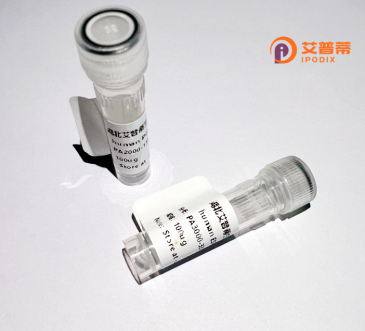
| 纯度 | >90%SDS-PAGE. |
| 种属 | Human |
| 靶点 | RECK |
| Uniprot No | O95980 |
| 内毒素 | < 0.01EU/μg |
| 表达宿主 | E.coli |
| 表达区间 | 1-971 aa |
| 活性数据 | MATVRASLRGALLLLLAVAGVAEVAGGLAPGSAGALCCNHSKDNQMCRDVCEQIFSSKSESRLKHLLQRAPDYCPETMVEIWNCMNSSLPGVFKKSDGWVGLGCCELAIALECRQACKQASSKNDISKVCRKEYENALFSCISRNEMGSVCCSYAGHHTNCREYCQAIFRTDSSPGPSQIKAVENYCASISPQLIHCVNNYTQSYPMRNPTDSLYCCDRAEDHACQNACKRILMSKKTEMEIVDGLIEGCKTQPLPQDPLWQCFLESSQSVHPGVTVHPPPSTGLDGAKLHCCSKANTSTCRELCTKLYSMSWGNTQSWQEFDRFCEYNPVEVSMLTCLADVREPCQLGCRNLTYCTNFNNRPTELFRSCNAQSDQGAMNDMKLWEKGSIKMPFINIPVLDIKKCQPEMWKAIACSLQIKPCHSKSRGSIICKSDCVEILKKCGDQNKFPEDHTAESICELLSPTDDLKNCIPLDTYLRPSTLGNIVEEVTHPCNPNPCPANELCEVNRKGCPSGDPCLPYFCVQGCKLGEASDFIVRQGTLIQVPSSAGEVGCYKICSCGQSGLLENCMEMHCIDLQKSCIVGGKRKSHGTSFSIDCNVCSCFAGNLVCSTRLCLSEHSSEDDRRTFTGLPCNCADQFVPVCGQNGRTYPSACIARCVGLQDHQFEFGSCMSKDPCNPNPCQKNQRCIPKPQVCLTTFDKFGCSQYECVPRQLACDQVQDPVCDTDHMEHNNLCTLYQRGKSLSYKGPCQPFCRATEPVCGHNGETYSSVCAAYSDRVAVDYYGDCQAVGVLSEHSSVAECASVKCPSLLAAGCKPIIPPGACCPLCAGMLRVLFDKEKLDTIAKVTNKKPITVLEILQKIRMHVSVPQCDVFGYFSIESEIVILIIPVDHYPKALQIEACNKEAEKIESLINSDSPTLASHVPLSALIISQVQVSSSVPSAGVRARPSCHSLLLPLSLGLALHLLWTYN |
| 分子量 | 132.9 kDa |
| 蛋白标签 | GST-tag at N-terminal |
| 缓冲液 | PBS, pH7.4, containing 0.01% SKL, 1mM DTT, 5% Trehalose and Proclin300. |
| 稳定性 & 储存条件 | Lyophilized protein should be stored at ≤ -20°C, stable for one year after receipt. Reconstituted protein solution can be stored at 2-8°C for 2-7 days. Aliquots of reconstituted samples are stable at ≤ -20°C for 3 months. |
| 复溶 | Always centrifuge tubes before opening.Do not mix by vortex or pipetting. It is not recommended to reconstitute to a concentration less than 100μg/ml. Dissolve the lyophilized protein in distilled water. Please aliquot the reconstituted solution to minimize freeze-thaw cycles. |
以下是关于重组人RECK蛋白的3篇代表性文献,包含文献名称、作者及摘要内容的简要概括:
---
1. **《RECK suppresses survival and tumorigenicity of glioma stem-like cells》**
*作者:Lu Y. et al. (2015)*
**摘要**:研究通过重组RECK蛋白表达,证明其通过抑制MMP-2/9活性阻断了胶质瘤干细胞(GSCs)的自我更新和肿瘤形成能力,揭示了其在神经胶质瘤治疗中的潜在作用。
---
2. **《Recombinant human RECK protein inhibits angiogenesis by targeting VEGF signaling》**
*作者:Wang L. et al. (2012)*
**摘要**:该文献报道重组RECK蛋白能下调血管内皮生长因子(VEGF)表达,抑制内皮细胞迁移和小管形成,表明其通过双重抑制MMPs和VEGF通路发挥抗血管生成作用。
---
3. **《Adenovirus-mediated RECK gene transfer inhibits hepatocellular carcinoma growth and metastasis》**
*作者:Chen X. et al. (2008)*
**摘要**:利用重组腺病毒载体递送RECK基因至肝癌细胞,结果显示其显著抑制MMP-2/9活性,减少肿瘤生长和肺转移,为肝癌基因治疗提供了实验依据。
---
以上文献聚焦重组RECK蛋白在癌症中的功能机制及治疗潜力,涵盖胶质瘤、血管生成和肝癌模型中的应用,突显其对MMPs及下游信号通路的调控作用。
**Background of Recombinant Human RECK Protein**
The Reversion-inducing Cysteine-rich Protein with Kazal motifs (RECK) is a membrane-anchored glycoprotein encoded by the *RECK* gene in humans. Initially identified as a tumor suppressor, RECK is widely recognized for its role in regulating extracellular matrix (ECM) remodeling by inhibiting key matrix metalloproteinases (MMPs), including MMP-2. MMP-9. and MMP-14. These enzymes are critical for ECM degradation, a process linked to cancer progression, angiogenesis, and metastasis. RECK achieves this through its conserved cysteine-rich repeats and Kazal-like domains, which interact with MMPs to suppress their activity.
RECK expression is often downregulated in various cancers due to promoter hypermethylation or transcriptional repression, correlating with poor prognosis. Its tumor-suppressive functions extend beyond MMP inhibition, influencing cell adhesion, apoptosis, and Wnt/β-catenin signaling. Recombinant human RECK (rhRECK) protein, produced via mammalian or bacterial expression systems, retains these bioactive properties and serves as a valuable tool for studying RECK-mediated pathways in vitro and in vivo.
Research on rhRECK highlights its therapeutic potential, such as restoring RECK expression to impair tumor invasiveness or synergizing with conventional therapies. Ongoing studies explore its utility in regenerative medicine, inflammation, and cardiovascular diseases, emphasizing its broad regulatory impact on tissue homeostasis and disease pathogenesis.
×